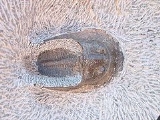
Harpetida
Encyclopedia
Harpetida is one of the nine order
s of the extinct
arthropod
class
Trilobita
. They lived from the Upper Cambrian
to the Late Devonian
period.
The Harpetida are characterized among trilobites by bearing a semicircular brim around the cephalon (head) which is often perforated by small pores. This brim is thought to serve as a filter-feeding apparatus. The brim stretches backward on either side of the cephalon (head) and typically has a pronounced suture along the outside.
The eyespots are typically reduced to small tubercles, though they have strong ridges stretching to the glabella (central region of the cephalon). They also typically have 12 or more thoracic segments. The pygidia
are usually small.
The Harpetida were formerly included in the family Ptychopariida
, but were recently given their own order (Ebach & McNamara 2002). The subclass Librostoma was created in 1990 by Richard Fortey
to cover the orders formally included with the Ptychopariida. The name Harpidae was once used as the name for the trilobite family containing the type genus Harpes. However, this is in conflict with the use of the same name for a family of extant molluscs and that taxon had precedence.
Order (biology)
In scientific classification used in biology, the order is# a taxonomic rank used in the classification of organisms. Other well-known ranks are life, domain, kingdom, phylum, class, family, genus, and species, with order fitting in between class and family...
s of the extinct
Extinction
In biology and ecology, extinction is the end of an organism or of a group of organisms , normally a species. The moment of extinction is generally considered to be the death of the last individual of the species, although the capacity to breed and recover may have been lost before this point...
arthropod
Arthropod
An arthropod is an invertebrate animal having an exoskeleton , a segmented body, and jointed appendages. Arthropods are members of the phylum Arthropoda , and include the insects, arachnids, crustaceans, and others...
class
Class (biology)
In biological classification, class is* a taxonomic rank. Other well-known ranks are life, domain, kingdom, phylum, order, family, genus, and species, with class fitting between phylum and order...
Trilobita
Trilobite
Trilobites are a well-known fossil group of extinct marine arthropods that form the class Trilobita. The first appearance of trilobites in the fossil record defines the base of the Atdabanian stage of the Early Cambrian period , and they flourished throughout the lower Paleozoic era before...
. They lived from the Upper Cambrian
Cambrian
The Cambrian is the first geological period of the Paleozoic Era, lasting from Mya ; it is succeeded by the Ordovician. Its subdivisions, and indeed its base, are somewhat in flux. The period was established by Adam Sedgwick, who named it after Cambria, the Latin name for Wales, where Britain's...
to the Late Devonian
Devonian
The Devonian is a geologic period and system of the Paleozoic Era spanning from the end of the Silurian Period, about 416.0 ± 2.8 Mya , to the beginning of the Carboniferous Period, about 359.2 ± 2.5 Mya...
period.
The Harpetida are characterized among trilobites by bearing a semicircular brim around the cephalon (head) which is often perforated by small pores. This brim is thought to serve as a filter-feeding apparatus. The brim stretches backward on either side of the cephalon (head) and typically has a pronounced suture along the outside.
The eyespots are typically reduced to small tubercles, though they have strong ridges stretching to the glabella (central region of the cephalon). They also typically have 12 or more thoracic segments. The pygidia
Pygidium
The pygidium is the posterior body part or shield of crustaceans and some other arthropods, such as insects and the extinct trilobites. It contains the anus and, in females, the ovipositor...
are usually small.
The Harpetida were formerly included in the family Ptychopariida
Ptychopariida
Ptychopariida is a large, heterogeneous order of trilobite containing some of the most primitive species known. Many date to the Early Cambrian Period, but the order was extant through the Late Ordovician...
, but were recently given their own order (Ebach & McNamara 2002). The subclass Librostoma was created in 1990 by Richard Fortey
Richard Fortey
Richard A. Fortey FRS is a British palaeontologist and writer.-Career:Richard Fortey studied geology at the University of Cambridge and had a long career as a palaeontologist at the Natural History Museum in London. Prof. Fortey’s research interests include, above all, trilobites...
to cover the orders formally included with the Ptychopariida. The name Harpidae was once used as the name for the trilobite family containing the type genus Harpes. However, this is in conflict with the use of the same name for a family of extant molluscs and that taxon had precedence.
External links
- Order Harpetida - from A Guide to the Orders of Trilobites by Sam Gon III

